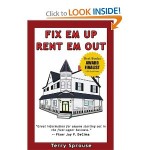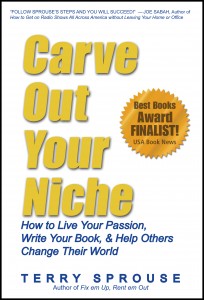YouTube is an inexpensive and powerful way to promote a book online. Maybe you’ve heard about it.
I make videos for YouTube on how to operate a fixer upper and rental house business, or on how to “carve out your niche” and how to self-publish. The best way to maximize views of YouTube videos that promote your books is to provide useful information that is helpful to people.
Five Keys for YouTube Success
1.) Be Subtle
Rather than making a video where you tell people to buy your book, it’s much better to make a video describing how your business operates, and why the type of business in general is a good business to be in. Subtlety always works better than beating people over the head with a sales promotion. Give your viewers something of value and they may return the favor.
For variety, and to broaden my appeal, sometimes I make a video designed simply to inspire people. I tell stories from my life that have inspiring messages, or describe ways that I find inspiration in my own life. In general, the better people know you, the more likely they are to become a customer.
2.) Keep it Short and Entertaining
Many videos on YouTube are long and boring, when they should be quick and fun. I keep my videos short, and I try to include humor in them. I will tell a story that has recently happened to me, or use something that I have recorded in my “humor” notebook, where I record quips or jokes that I have come across.
3.) No Adlibbing
To make sure that I come across as professionally as possible, I write a script before I start recording. The script doesn’t have to be word for word what you plan to say, but just an outline so that you know the key points that you want to make. I always try to include quotes from famous people, and, of course, humor and stories.
Unless you’re Jay Leno, don’t try to adlib your way through a video. It just won’t look as good as you think it does. Think, “nose piercing.”
4.) Break it up into Pieces
Now I do my videos in segments. I will look at my script and decide what I want to say about one key point. I record myself talking about that one point. Then I stop the camera and study the next key point, and so on.
Try to look right into the camera, and speak in a friendly voice as though you were talking to your best friend.
5.) Don’t Overanalyze
Don’t try to overanalyze making videos. As Douglas Adams said,
If you try and take a cat apart to see how it works, the first thing you have on your hands is a non-working cat.
My First Video
For the first video that I made (where I was actually on screen), I was so nervous that I actually wrote out the entire script and read it into the camera. I had my son, Bryan, holding the script next to the camera so that it wouldn’t look like I was reading it.
My son commented, “Surely, people will know that you are just reading.”
I said, “No way. I’ll read it like I talk. And don’t call me Shirley!”
Bryan was right. It did kind of look like I was reading.
At the end of the video, I was going to stand up and walk away down a peaceful rural path with my dog Blackie (the Wonder Dog), and I got tangled up in the microphone wire. And, the camera pan was jerky as I walked away. The video was unraveling into a Three Stooges experience, but none of that mattered. All that mattered was I somehow got the first video finished and posted.
I did this video before I started using an editing program so, like live TV, we had to get it all on one take.
Here is that first live video, warts and all, entitled “Walk Away From Your Problems and Find Inspiration.”
Two Alternatives to Using a Movie Camera
1. For the Camera Shy
If you really do not wish to appear in a video, you can still produce videos. You can use Easy Screen Capture Video, or ESCV (or any number of similar companies) and just do a voice over of a power point presentation, or use screen shots. It’s amazingly simple to do. You don’t even need a camera.
Here is the first video that I made using the ESCV technology, entitled “Start a Fixer Upper and Rental House Business” (which, looking back seems to run too long).
2. The Economical Way
If you want to do it the cheap and easy way, you can just record your videos using an video camera attached to your computer. I have a Logtech camera that captures sound and video. It clips onto the top of my screen and plugs into a USB port of my computer.
We’re Not Filming “War and Peace”
It’s tempting to think, “I don’t want to show this video to the world until it’s perfect.” Come on, you’re not Quentin Tarantino. We’re not aiming for a masterpiece here. You have to swallow your pride, and just put the video on YouTube, even if it has a few flaws.
People will overlook mistakes, especially if you have good content. My attitude is: my videos are not great, but I’m getting better each time I make another one. The more videos I make the better I get.
In this later video, “The Secret to Success in Less than 2 Minutes.” I employed several of the techniques that I have mentioned. It’s my most popular video with 3,200 views.
Camera and Editing
The camera that I use to record video is the Kodak Zi8. It’s small, easy to use and makes very clear videos. I also recommend that you have a tripod, a remote control, an external microphone, and an 8 GB flash memory card.
For editing, I use Windows Live Movie Maker, which is free if you have Windows. It allows you to cut and paste your video, and add music and titles.
Show People How to Do It!
Most people don’t want to waste time reading how to fix a leaky sink, or repair a car lock, or start a real estate business. They want to see how to do it!
They go to YouTube for answers.
That’s why your videos should be there.
This week’s recommended articles from the blogosphere:
Accepting The Value Of An Emergency Fund at Modest Money
Hi There, What Can You Tell Me About Yourself? at Frugal Rules
Halloween Humor: Random Things I’m Scared Of Eyes on the Dollar
Reader tip: Earn a little extra change by becoming a mail decoy at Money Saving Mom
Trick Or Treat {Finer Things Friday} at The Finer Things in Life
How Not to Take a Blogging Hiatus at Making Sense of Cents
Real Estate 101: Finding Good Tenants at Free Money Finance
Save Money With Coupons This Holiday Season at Work Save Live
Fearless Men’s Beard and Mustache Competition | Movember 2012 at Fearless Men
_____________________
Coming Soon!

































